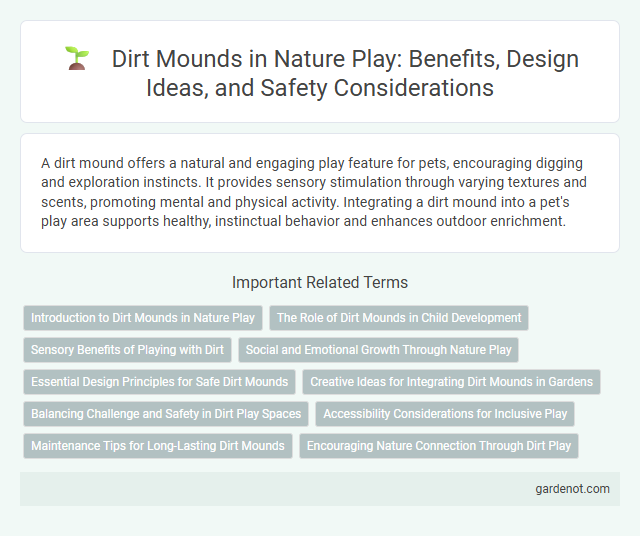A dirt mound offers a natural and engaging play feature for pets, encouraging digging and exploration instincts. It provides sensory stimulation through varying textures and scents, promoting mental and physical activity. Integrating a dirt mound into a pet's play area supports healthy, instinctual behavior and enhances outdoor enrichment.
Introduction to Dirt Mounds in Nature Play
Dirt mounds serve as dynamic natural elements in nature play, stimulating children's sensory exploration and imaginative adventures. These earthy formations allow kids to dig, climb, and shape the terrain, enhancing gross motor skills and fostering a deep connection with the environment. Incorporating dirt mounds in outdoor play spaces supports physical development while encouraging creativity and environmental stewardship.
The Role of Dirt Mounds in Child Development
Dirt mounds serve as dynamic natural tools that enhance sensory exploration and motor skill development in children by encouraging climbing, digging, and imaginative play. These earthy structures stimulate cognitive growth by fostering problem-solving abilities and creativity as children manipulate the terrain and engage in social interactions. Regular exposure to dirt mounds also promotes physical strength and balance, contributing to holistic outdoor learning experiences crucial for healthy child development.
Sensory Benefits of Playing with Dirt
Playing with dirt mounds enhances children's sensory development by stimulating tactile senses through varied textures and temperatures. The natural uneven surfaces encourage fine motor skills and spatial awareness, promoting physical coordination and cognitive growth. Exposure to soil microbes also supports immune system health and fosters a deeper connection to the environment.
Social and Emotional Growth Through Nature Play
Dirt mounds provide children with hands-on opportunities to engage in collaborative problem-solving and imaginative play, fostering essential social skills such as communication and teamwork. Exploring and manipulating natural materials like soil enhances emotional resilience by allowing kids to express creativity and manage frustrations in a supportive outdoor environment. This tactile interaction with nature supports self-regulation and empathy, key components of social and emotional development in early childhood.
Essential Design Principles for Safe Dirt Mounds
Safe dirt mounds in nature play must incorporate stable slopes with a gradient no steeper than 2:1 to prevent slips and falls while allowing children to climb easily. Using compacted soil with low erosion potential enhances durability and reduces maintenance, ensuring long-term safety. Integrating varied textures and organic materials supports sensory exploration while minimizing hard landing zones to protect against injuries.
Creative Ideas for Integrating Dirt Mounds in Gardens
Dirt mounds transform gardens into dynamic play landscapes, sparking children's imagination and physical activity. Incorporating tunnels, wooden balance beams, or plant-covered slopes enhances sensory exploration and motor skills development. Strategically placed near flower beds or water features, these mounds create natural climbing challenges and cozy hideouts that blend seamlessly with garden aesthetics.
Balancing Challenge and Safety in Dirt Play Spaces
Dirt mounds in nature play areas offer children a dynamic environment to develop balance, coordination, and spatial awareness while engaging in physical activity. Careful design ensures the slopes and heights present sufficient challenge to promote skill-building without compromising safety, using natural materials and gradual inclines to minimize injury risk. Incorporating soft landing zones and clear boundaries supports a secure play experience that encourages exploration and confidence on uneven terrain.
Accessibility Considerations for Inclusive Play
Dirt mounds designed for nature play should incorporate gentle slopes and wide, stable pathways to ensure wheelchair accessibility and safe exploration for children with mobility challenges. Using textured surfaces and tactile elements on the mound can enhance sensory engagement for children with visual impairments. Inclusive design principles promote equal access, encouraging diverse abilities to interact meaningfully with natural play environments.
Maintenance Tips for Long-Lasting Dirt Mounds
Regularly inspect dirt mounds for erosion and compact areas to maintain stability and safety. Incorporate natural barriers like mulch or rocks around the base to reduce soil displacement from weather and heavy use. Routinely replenish soil and address drainage issues to prevent water pooling and preserve the mound's shape and durability.
Encouraging Nature Connection Through Dirt Play
Dirt mounds serve as natural play structures that encourage children to engage physically and imaginatively with the environment, fostering a deep connection to nature. Playing on and around dirt mounds promotes sensory exploration, motor skills development, and an understanding of natural processes such as erosion and soil composition. These interactive experiences support environmental awareness and inspire lifelong curiosity about the natural world.
Dirt mound Infographic

 gardenot.com
gardenot.com